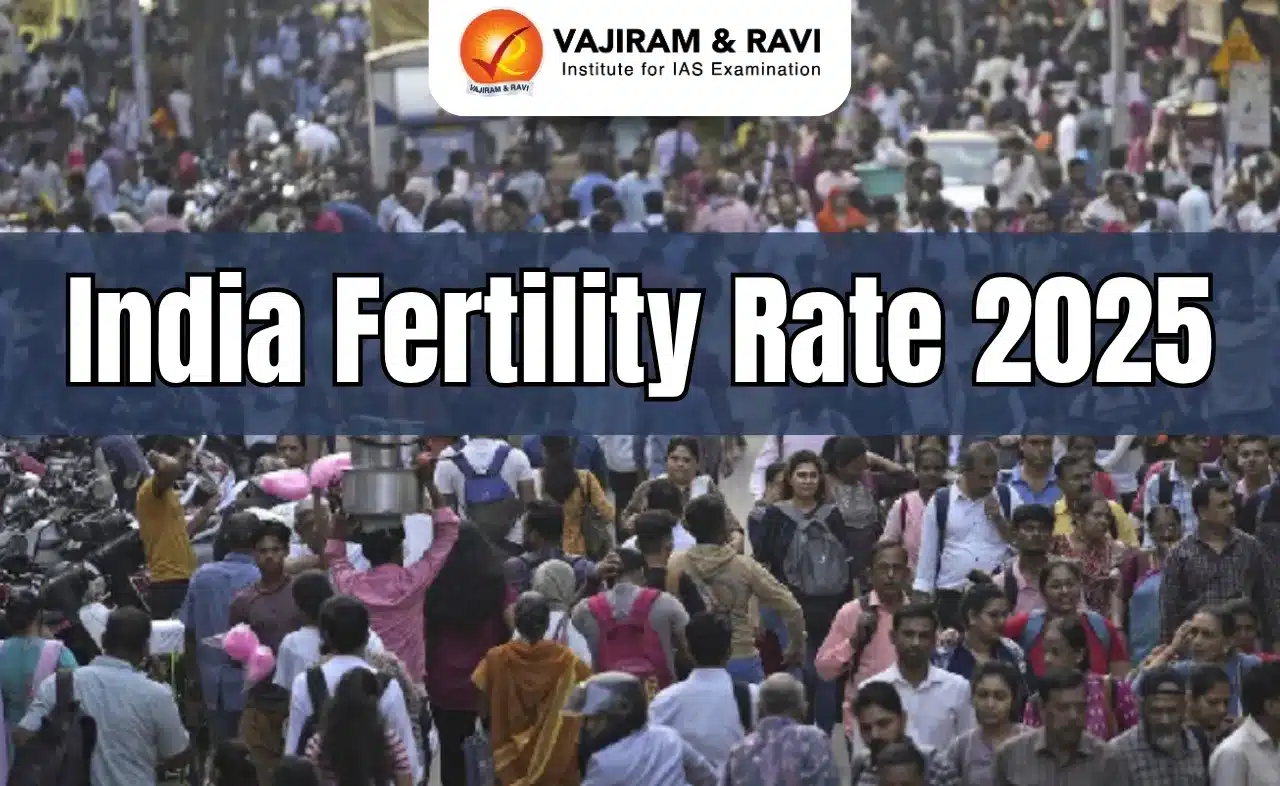India Fertility Rate Latest News
- India’s population is estimated to have reached 146.39 crore by April, says a new UN demographic report.
India’s Fertility Rate Falls Below Replacement Level
- India’s fertility rate has declined to 1.9, falling below the replacement level of 2.1, according to the United Nations Population Fund (UNFPA) report State of World Population 2025.
- This demographic transition, while not unique to India, signals a long-term shift in population trends driven by a complex mix of economic, social, and health-related factors.
- Despite this decline, India remains the world’s most populous country, with an estimated population of 146.39 crore as of April 2025.
- The population is projected to peak around 170 crore over the next four decades before beginning to shrink.
From High Fertility to Demographic Transition
- In 1960, Indian women had an average of six children. Since then, India has achieved a dramatic reduction in fertility rates, largely through enhanced access to reproductive healthcare, greater educational outreach, and sustained efforts at women’s empowerment.
- The UNFPA attributes this demographic shift not to coercive policies but to an organic transition supported by awareness campaigns and policy interventions.
- The decline aligns with India’s own projections, such as those published in the National Family Health Survey (NFHS-5), which pegged the 2022 fertility rate at 2.0 nationally, with urban fertility at 1.6 and rural fertility at 2.1.
- Some states, however, still have above-average fertility rates, including Bihar (2.98), Meghalaya (2.9), Uttar Pradesh (2.35), Jharkhand (2.26), and Manipur (2.2).
Financial Constraints and Changing Aspirations
- The report reveals that financial strain is a leading factor in decisions to have fewer children.
- Around 38% of Indian respondents cited economic challenges, while 21% pointed to job insecurity or unemployment.
- Globally, similar concerns are evident, with an average of 39% across 14 countries expressing financial limitations as the primary reason for having fewer children than desired.
- There is also a growing disconnect between the ideal number of children and the number couples expect to have.
- While 41% of women surveyed in India considered two children as ideal, 7% of respondents below 50 stated they expected fewer than the ideal due to economic and social pressures.
Social and Familial Dynamics
- Family dynamics play a pivotal role in fertility decisions. Around 19% of respondents said their partner preferred fewer children, and 15% said lack of support in household responsibilities affected their reproductive choices.
- Additionally, healthcare professionals were also cited as influencing decisions, 14% of Indian respondents said pressure from doctors or health workers led them to have fewer children than they desired. This highlights a concerning gap between reproductive rights and institutional practices.
India’s Demographic Dividend and Ageing Population
- With 68% of India’s population in the working-age group (15-64 years), the country still enjoys a significant demographic dividend.
- However, this window is not infinite. As life expectancy increases, projected at 71 years for men and 74 for women, India’s elderly population (currently 7%) is expected to rise steadily in the coming decades.
- This shift necessitates strategic investments in health, social security, and workforce policies to sustain economic growth even as fertility declines.
Beyond Population Numbers: The Real Fertility Crisis
- The UNFPA report emphasizes that the real crisis is not overpopulation or underpopulation but rather the inability of individuals to realize their fertility intentions.
- It calls for safeguarding reproductive agency, the right to make informed choices about sex, contraception, and family planning, especially in rapidly changing socio-economic contexts.
- This shift in framing from a numbers-based discourse to a rights-based approach underscores the need to go beyond demographic targets and prioritize empowerment, choice, and health access.
Policy Considerations and Future Outlook
- India must adapt its health and welfare policies to reflect this demographic reality. Key focus areas should include:
- Enhancing women’s participation in the workforce.
- Expanding social support for childcare and elderly care.
- Reforming workplace norms to reduce the economic burden of parenting.
- Investing in universal access to contraception and fertility counselling.
- The upcoming 2027 Census, delayed from 2021, will offer updated insights critical to informing policy.
- In the meantime, India’s demographic strategy must pivot from population control to inclusive, rights-based population governance.
India Fertility Rate 2025 FAQs
Q1. What is India’s current fertility rate according to the 2025 UN report?
Ans. India’s fertility rate has dropped to 1.9, below the replacement level of 2.1.
Q2. Which states still have fertility rates above the national average?
Ans. Bihar, Meghalaya, Uttar Pradesh, Jharkhand, and Manipur have higher-than-average fertility rates.
Q3. What factors are influencing Indians to have fewer children?
Ans. Financial strain, job insecurity, lack of partner support, and healthcare pressure are major factors.
Q4. What is India’s current population and when is it expected to decline?
Ans. India’s population is 146.39 crore and is expected to peak at 170 crore before starting to decline in about 40 years.
Q5. What does the UN report identify as the “real fertility crisis”?
Ans. The real crisis is individuals being unable to achieve their desired number of children, not overpopulation.
Source: TH



